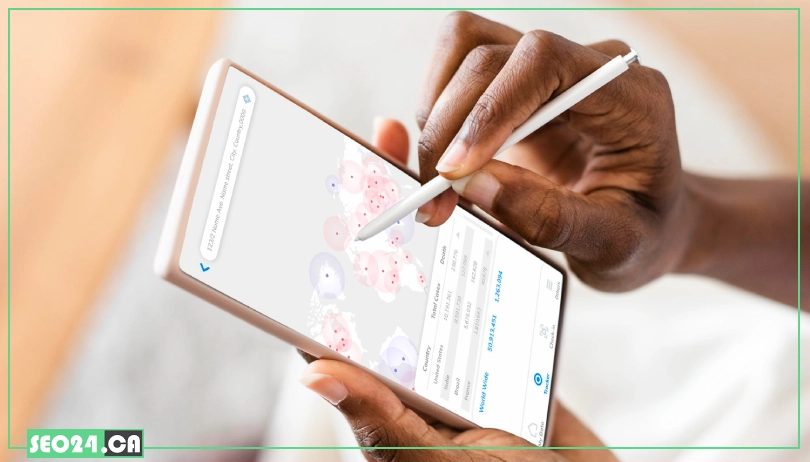
Improve Google Maps Ranking
If your business doesn’t show up on Google Maps, it might as well not exist. In today’s world, most people turn to Google Maps first when looking for local services—and your ranking can make the difference between being noticed and being overlooked. In this blog, you’ll discover practical, proven strategies to boost your Google Maps ranking and drive more visibility, foot traffic, and customers your way.
Table of Contents
How Google Maps Ranking Works?
Understanding how Google Maps ranks businesses is essential for improving your visibility and driving more customers to your doorstep. The ranking algorithm is influenced by various factors, including relevance, distance, and prominence. When a user searches for a local service or product, Google aims to provide the most relevant and useful results based on these criteria.
- Relevance: How well your business matches the search query. Google uses information from your Google Business Profile (like business description, categories, and keywords) to determine relevance.
- Distance: The proximity of your business to the searcher’s location. Google favors businesses closer to the searcher, although this is relative — a more relevant result may still rank higher even if it’s further away.
- Prominence: This reflects how well-known your business is. Businesses that have more online reviews, higher ratings, and strong website authority generally rank higher. Google also considers links, articles, and other sources of information about your business when determining prominence.
Actionable Strategies to Rank Higher
If you want to outrank competitors on Google Maps, optimizing your presence requires more than just setting up a profile. Here’s how to make your business stand out in 2025 and beyond:
1- Optimize Your Google Business Profile (GBP)
Your Google Business Profile is your storefront on Maps. Make it count:
- Complete Every Section: Fill in all available fields — hours, website, attributes, etc. Incomplete profiles often underperform.
- Accurate Business Name, Address, Phone Number (NAP): Ensure consistency across your website, directories, and GBP. Google cross-checks this info.
- Choose the Right Categories: Be specific. “Italian Restaurant” is better than just “Restaurant.”
- Write a Compelling Business Description: Clearly explain what you do, who you serve, and what makes you different — use relevant keywords naturally.
- High-Quality Photos and Videos: Visuals boost engagement and trust. Showcase your space, team, products, or customer experience.
- Utilize Google Posts: Share updates, offers, events, or blog links regularly to keep your profile active and fresh.
- Answer Questions Promptly: Use the Q&A feature as a mini FAQ. Monitor and respond fast — inaccurate answers can harm trust.
- Enable Messaging: Let customers contact you directly. Fast replies can improve your visibility.
- Showcase Products and Services: Add detailed info to help users decide — especially important if you’re in retail or B2C services.
SEO24 Agency boosts your local visibility with expert Google My Business optimization service. We optimize your profile, manage reviews, and enhance listings to attract more customers—helping you rank higher on Google Maps and drive sales.
2- Master Reviews
Reviews are one of the strongest local ranking signals. They directly influence your credibility and your position on Google Maps.
- Encourage Reviews: Actively ask happy customers to leave reviews — in person, via email, or through a link. More (and better) reviews improve your local authority. To truly supercharge your review collection efforts, explore all the best strategies in our article: “how to increase Google reviews?“
- Respond to All Reviews: Thank customers for positive feedback and handle negative reviews professionally. Engaging with reviews shows you’re active and trustworthy. If you encounter reviews that are fake or violate Google’s policies, you might be able to get them taken down. Our detailed guide on “how to remove negative Google reviews” provides all the steps and information you need to address these situations effectively.
- Monitor Your Reviews: Track new reviews regularly. Spot trends, address issues early, and use feedback to improve your service and online reputation.
3- Build Consistent Local Citations
Local citations are mentions of your business’s Name, Address, and Phone number (NAP) across the web — like in directories, apps, and local business listings.
Google uses these signals to verify the legitimacy and relevance of your business. Make sure your NAP is consistent across all platforms — including Yelp, Apple Maps, Bing Places, Foursquare, Yellow Pages, and local directories. Inconsistencies can hurt trust and confuse Google, weakening your Maps visibility. High-quality, relevant citations also boost local SEO by reinforcing your business presence in your service area.
4- Optimize Your Website for Local SEO
Your website directly supports your Google Maps ranking — it tells Google you’re a legitimate local business worth showing to searchers. Here’s how to optimize it effectively:
- NAP on Your Website: Make sure your business name, address, and phone number (NAP) appear clearly on every page, typically in the footer.
- Local Keywords: Use relevant local search terms (e.g., “dentist in downtown Toronto”) throughout your content, meta descriptions, and headers.
- Location Pages: If you serve multiple areas, create a unique, optimized page for each location to boost visibility in different local searches.
- Schema Markup: Implement local business schema markup so Google better understands your business type, hours, and location.
- Mobile-Friendliness: A large portion of local searches come from smartphones. Make sure your site is responsive and easy to navigate.
- Page Speed: A slow-loading site frustrates users and may push your ranking down. Tools like PageSpeed Insights can help you identify quick wins for improvement.
5- Leverage Social Media (Indirectly)
While social media signals aren’t a direct Google Maps ranking factor, they can strongly influence your local visibility in indirect but powerful ways:
- Drive Traffic to Your Website: Sharing local content, promotions, or blog posts via platforms like Instagram, Facebook, or LinkedIn can bring engaged traffic to your site — which helps Google assess your relevance and authority.
- Boost Brand Awareness: Active local engagement on social platforms can build trust and recognition in your area, leading more users to search for your business by name (a key ranking signal).
- Encourage Check-Ins and Mentions: When customers tag your location or leave shoutouts, it increases your digital footprint, which supports your local presence.
- Link to Your Google Business Profile: Always include a link to your GBP in bios, posts, and stories to funnel happy followers into writing reviews or contacting you directly.
6- Encourage Check-Ins and Photos
User-generated content like check-ins and photos plays a subtle yet impactful role in improving your visibility on Google Maps:
- Check-Ins Signal Activity: When customers check in at your location on platforms like Facebook or Instagram, it sends indirect signals to Google that your business is active, popular, and trustworthy.
- Photos Enhance Your GBP: Encouraging customers to upload their own photos to your Google Business Profile creates a more dynamic, authentic listing. Google favors profiles with frequent updates and rich media.
- Builds Social Proof: Real customer photos and check-ins increase credibility and help future customers visualize your space, products, or services — which may increase foot traffic and engagement.
- Easy Promotion: Display signage in-store or add a line on receipts inviting customers to check in or upload a quick pic — sometimes a simple nudge goes a long way.
7- Monitor Your Performance and Iterate:
Tracking your Google Maps performance is key to long-term growth. Without regular review, you may miss opportunities to improve visibility or correct issues:
- Use Google Business Profile Insights: GBP provides valuable metrics like how users found your business (search vs. maps), what actions they took (calls, website visits, directions), and peak engagement times.
- Track Website & Conversion Metrics: Connect your GBP to Google Analytics to understand how local traffic behaves once it lands on your site — and whether it’s converting.
- Monitor Local Keyword Rankings: Use SEO tools to track how your business ranks for high-priority keywords in your area.
- Test and Adjust Regularly: If certain posts, images, or keywords are driving engagement, double down on them. If not, refine your content and strategy.
- Stay Updated: Google’s algorithm changes frequently. Keep an eye on updates and tweak your profile and local SEO practices accordingly.
Common Mistakes to Avoid
Even the most well-intentioned local SEO efforts can fail if basic pitfalls are overlooked. Here are some frequent mistakes that can seriously harm your Google Maps ranking:
- Inconsistent NAP information: Your business Name, Address, and Phone Number must be exactly the same across all platforms — websites, directories, and social media. Even small differences confuse Google and reduce trust.
- Ignoring reviews: Not responding to reviews (especially negative ones) signals a lack of engagement. Google favors businesses that actively interact with their audience.
- Incomplete or inaccurate GBP: Leaving sections blank or using outdated info weakens your profile’s strength and can lead to lower visibility.
- Lack of local keywords on your website: If your content doesn’t reflect your geographic location and services, you’ll miss out on local intent searches.
- Poor quality photos: Low-resolution, outdated, or irrelevant images don’t inspire trust. Google also prefers fresh visual content.
- Not using Google Posts: This underused feature can boost engagement and show Google you’re active. Skipping it is a missed opportunity.
To stay ahead in local SEO and avoid these common missteps, having the right strategy and guidance is key. That’s where we come in: seo in toronto. Our team of local SEO specialists helps Toronto businesses improve their Google Maps visibility, fix inconsistencies, and implement best practices that get real results. Whether you need help optimizing your Google Business Profile, managing your reviews, or boosting your local presence through content and technical SEO—we’ve got the tools, experience, and strategy to make it happen.
Conclusion
Boosting your Google Maps ranking is crucial for increasing your business’s visibility and attracting more local customers. By optimizing your Google Business Profile, gathering positive reviews, ensuring consistent citations, and leveraging local SEO tactics, you can significantly improve your chances of ranking higher. Remember, it takes time, consistency, and a focused strategy to see real results.
For professional guidance and expert support in achieving your local SEO goals, reach out to us at seo24 digital marketing agency.
Related Posts
Learn what SEO is and why it's crucial for your business. Find out how optimizing your website can boost…
by
Having a great website is just the first step. To get people to visit it, they need to be…
by
As voice search becomes more popular, it's clear that people are changing how they look for information online. Users…
by
With the rise of zero-click searches, ranking at the top of Google's search results has taken on a new…
by


